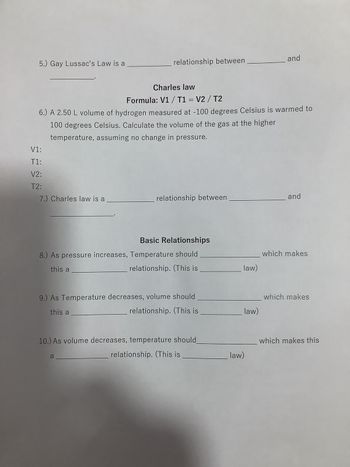1.) A sample of oxygen had an initial volume of 4.0L and was at a standard pressure of latm, what would the new volume be if the pressure was increased to 25.00atm? P1: V1: P2: V2: Boyles law is a relationship between Converting between Celsius and Kelvin 2.) Convert the following temperatures from C to K a.) 30° C = b.) 10° C = c.) 4° C = P1: T1: P2: T2: K K K and 3.) The most important thing to remember when working Gas law problems involving temperature is to convert from to Gay Lussac's Law Formula: P1 / T1 = P2/T2 4.) 5.00 L of a gas is collected at 22.0° C and 745.0 mmHg. When the temperature increases to 35° C what is the new pressure?
1.) A sample of oxygen had an initial volume of 4.0L and was at a standard pressure of latm, what would the new volume be if the pressure was increased to 25.00atm? P1: V1: P2: V2: Boyles law is a relationship between Converting between Celsius and Kelvin 2.) Convert the following temperatures from C to K a.) 30° C = b.) 10° C = c.) 4° C = P1: T1: P2: T2: K K K and 3.) The most important thing to remember when working Gas law problems involving temperature is to convert from to Gay Lussac's Law Formula: P1 / T1 = P2/T2 4.) 5.00 L of a gas is collected at 22.0° C and 745.0 mmHg. When the temperature increases to 35° C what is the new pressure?
Chemistry
10th Edition
ISBN:9781305957404
Author:Steven S. Zumdahl, Susan A. Zumdahl, Donald J. DeCoste
Publisher:Steven S. Zumdahl, Susan A. Zumdahl, Donald J. DeCoste
Chapter1: Chemical Foundations
Section: Chapter Questions
Problem 1RQ: Define and explain the differences between the following terms. a. law and theory b. theory and...
Related questions
Question

Transcribed Image Text:Gas Laws Practice Worksheet - Boyles, Gay lussacs, Charles
Boyles Law
Formula: P1V1 = P2V2
1.) A sample of oxygen had an initial volume of 4.0L and was at a standard
pressure of latm, what would the new volume be if the pressure was
increased to 25.00atm?
P1:
V1:
P2:
V2:
Boyles law is a
relationship between
Converting between Celsius and Kelvin
2.) Convert the following temperatures from ° C to K
a.) 30° C =
b.) 10° C =
c.) 4° C =
P1:
T1:
P2:
T2:
K
K
K
Name:
and
3.) The most important thing to remember when working Gas law problems
involving temperature is to convert from
Gay Lussac's Law
Formula: P1 / T1 = P2/T2
4.) 5.00 L of a gas is collected at 22.0° C and 745.0 mmHg. When the
temperature increases to 35° C what is the new pressure?
to

Transcribed Image Text:Gas Laws Practice Worksheet - Boyles, Gay lussacs, Charles
Boyles Law
Formula: P1V1 = P2V2
1.) A sample of oxygen had an initial volume of 4.0L and was at a standard
pressure of latm, what would the new volume be if the pressure was
increased to 25.00atm?
P1:
V1:
P2:
V2:
Boyles law is a
relationship between
Converting between Celsius and Kelvin
2.) Convert the following temperatures from ° C to K
a.) 30° C =
b.) 10° C =
c.) 4° C =
P1:
T1:
P2:
T2:
K
K
K
Name:
and
3.) The most important thing to remember when working Gas law problems
involving temperature is to convert from
Gay Lussac's Law
Formula: P1 / T1 = P2/T2
4.) 5.00 L of a gas is collected at 22.0° C and 745.0 mmHg. When the
temperature increases to 35° C what is the new pressure?
to
Expert Solution
This question has been solved!
Explore an expertly crafted, step-by-step solution for a thorough understanding of key concepts.
This is a popular solution!
Trending now
This is a popular solution!
Step by step
Solved in 3 steps with 1 images

Follow-up Questions
Read through expert solutions to related follow-up questions below.
Follow-up Question

Transcribed Image Text:5.) Gay Lussac's Law is a
V1:
T1:
V2:
T2:
Charles law
Formula: V1 / T1 = V2/T2
6.) A 2.50 L volume of hydrogen measured at -100 degrees Celsius is warmed to
100 degrees Celsius. Calculate the volume of the gas at the higher
temperature, assuming no change in pressure.
7.) Charles law is a
relationship between
relationship between
Basic Relationships
8.) As pressure increases, Temperature should
this a
relationship. (This is
9.) As Temperature decreases, volume should
this a
relationship. (This is
a
10.) As volume decreases, temperature should
relationship. (This is
law)
law)
and
law)
and
which makes
which makes
which makes this
Solution
Knowledge Booster
Learn more about
Need a deep-dive on the concept behind this application? Look no further. Learn more about this topic, chemistry and related others by exploring similar questions and additional content below.Recommended textbooks for you

Chemistry
Chemistry
ISBN:
9781305957404
Author:
Steven S. Zumdahl, Susan A. Zumdahl, Donald J. DeCoste
Publisher:
Cengage Learning

Chemistry
Chemistry
ISBN:
9781259911156
Author:
Raymond Chang Dr., Jason Overby Professor
Publisher:
McGraw-Hill Education

Principles of Instrumental Analysis
Chemistry
ISBN:
9781305577213
Author:
Douglas A. Skoog, F. James Holler, Stanley R. Crouch
Publisher:
Cengage Learning

Chemistry
Chemistry
ISBN:
9781305957404
Author:
Steven S. Zumdahl, Susan A. Zumdahl, Donald J. DeCoste
Publisher:
Cengage Learning

Chemistry
Chemistry
ISBN:
9781259911156
Author:
Raymond Chang Dr., Jason Overby Professor
Publisher:
McGraw-Hill Education

Principles of Instrumental Analysis
Chemistry
ISBN:
9781305577213
Author:
Douglas A. Skoog, F. James Holler, Stanley R. Crouch
Publisher:
Cengage Learning

Organic Chemistry
Chemistry
ISBN:
9780078021558
Author:
Janice Gorzynski Smith Dr.
Publisher:
McGraw-Hill Education

Chemistry: Principles and Reactions
Chemistry
ISBN:
9781305079373
Author:
William L. Masterton, Cecile N. Hurley
Publisher:
Cengage Learning

Elementary Principles of Chemical Processes, Bind…
Chemistry
ISBN:
9781118431221
Author:
Richard M. Felder, Ronald W. Rousseau, Lisa G. Bullard
Publisher:
WILEY